‘How Shiny are YOUR Balls?’
Joanne says all mini-van drivers must get a lobotomy
before they can purchase their vehicles . . . at least they
drive that way.
Me, I look at all the humongous SUV’s. Each one bigger
than the last, with ‘rough & tough’ all-terrain
attitude & tread, yet with ZERO ground clearance.
Typically, the spare is also stored underneath as well. A common
‘option’ is usually a receiver hitch, with an un-locked
bar & bright shiny ball.
You can always tell a vehicle ‘that works for a living’.
Any attachment is usually banged up and covered with rust. The
more ‘frugal’ {that’s cheap,
like me} will keep the hitch bar inside, with the well-greased
ball covered. My trailer ‘dolly’ gets the same treatment.
Just last week they were both put to good use.
For the last four years I’ve had a 1983 West Wight Potter
15 sitting on some tires in my back drive. It came with the
original trailer. This wouldn’t have been so bad, but
the first two owners used the boat in salt water . . . and never
washed the trailer. At least one gusset was rusted through,
and big chunks were falling off the frame. While the frame itself
sounded good when struck with a short maul, could the welds
on the spring holders be trusted ?? The tires were only a few
years old but the wheel bolts seemed rusted in place, and the
nuts & bolts holding the support rollers were split by rust.
All in all, as a ‘work stand’ it looked fine, but
I didn’t trust it on the road. Plus, it would cost at
least 2/3rds of the price of a new trailer to properly re-furbish
it. I finally sold it to someone at the Club for a launching
‘beach buggy’.
One of the reasons for the delay was I failed to do my usual
‘research’. Seeing all the different trailers at
the Club, and reading the comments on the Groups, I figured
there were the ‘usual’ six or seven manufacturers
I remembered. How wrong that turned out to be !! Even
though they are located here in the Mid-Atlantic area {one,
literally on the outskirts of Philly}, there appears to be only
THREE ‘production’ manufacturers
left. Plus, it seems nothing is welded anymore . . . just ‘Tinkertoy’
bolted together.
Anyway, a few weeks ago I finally got everything together and
bought a new trailer. It wasn’t a ‘Potter’
trailer, but the smallest LoadRite ‘Bandit’ model.
The designation/catalog gave the capacity as 800 pounds. The
Certification sticker on the tongue said 980 pounds, NET.
More than enough capacity for a boat that weighs less than 500
pounds. The important things, to me, was that it had both three
‘cross beams’ and ‘rotating’ flat bunks.
{That’s why I had to physically SEE the trailers. While
the literature didn’t show it, one of the manufacturers
has the bunks permanently fixed in the 800 & 1,000
pound models}. When we ‘decanted’ the boat from
the original trailer, the ‘tilting’ mechanism allowed
us to raise the bow of the boat as high as necessary. Presently,
there doesn’t seem to be any who have a ‘standard’
tilt-bed boat trailer {those made for International Marine not
withstanding} Since we had to ‘recover’ the boat
twice, I found that with the ‘proper placement’
of the bunks, the hull wasn’t scratched, and cranking
the winch could easily rotate the ENTIRE trailer {forward of
the wheels} up in the air.
As the boat was drawn up the bunks, the center of gravity shifted
and the tongue came down . . . of course the judicious use of
my ‘rail meat’ helped. However, even though I had
measured carefully, the hull was askew. One was ‘outside’
of one of the small ‘skegs’ or ‘runners’,
formed in the hull, and the other was ‘inside’ the
opposite one. I was afraid this would allow the hull to shift
sideways due to the normal vibration of highway travel.
I had thought ahead, made sketches and taken measurements from
the old trailer. The intention was to save money by ordering
the parts from a trailer speciality company. However, and ‘as
usual’ things conspired to change that. Because of unexpected
incidents, I was 6 months behind in the intended schedule. Getting
the trailer, and the beginning of the sailmakers ‘busy
season’ occurred simultaneously. {Her 15-foot mast is
light & ‘whippy’ when unsupported, so I actually
needed a long trailer, or the boat on a trailer, to carry the
mast to the sailmaker . . . he wanted the mast & boom on
hand to properly ‘set’ the slugs - the fact that
he had been holding the sail and waiting for 4 years is another
story !!} Therefore, after I had asked him about my sail, I
didn’t want to delay any longer. What was needed were
a set of short ‘Self Adjusting’ bunks, inboard of
the others, that would just straddle the central ‘skeg
keel’. These would act both to center the boat, and ease
the bow up at recovery, so the outer bunks wouldn’t scrape
on the hull.
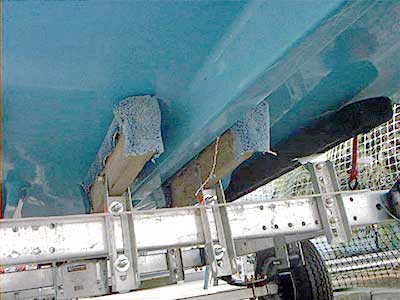
detail of self-adjusting bunks
There were holes in the aft frame 6 inches apart - but I wasn’t
sure that was quite wide enough. Therefore I needed to get a
pair of ‘Square U’ bolts as well as the proper brackets.
By the end of the next day, after trips to a couple of trailer
& marine stores, I had the proper brackets & ‘U’
bolts, plus 8 inch and 5 inch keel rollers with their respective
brackets. That evening we ‘decanted’ the boat .
. . again. Joanne’s only comment was, “You had
better get it right, . . . this time ”. I also found
out that I can lift the entire front of the boat to shoulder
height . . . {so much for what the cardiologist has to say .
. .}.
Anyhow, the next day I made up a couple of 18 inch long ‘vertical’
bunks from Pressure Treated 2x4's and padded them with pieces
of carpet . . . left over from what I scrounged to cover the
bunks on the P19 trailer, several years ago. Drilled holes,
and bolted them to the brackets with galvanized bolts, lock
washers, & nuts. Placed them on the rear cross beam, about
8 inches apart {from Joanne’s comments}, and secured by
the ‘U’ brackets.
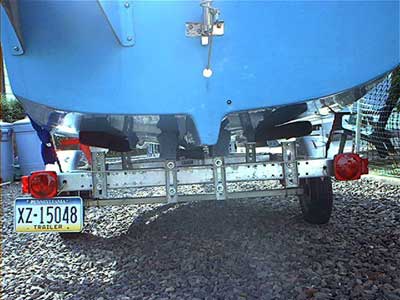
astern - all four bunks
I also installed the 8 inch keel roller & bracket on the
‘mid’ cross beam. The idea here was two-fold . .
. to prevent the forefoot from accidentally banging on it, if
the hull support bunks were to wide apart, and to actually take
the majority of the weight of the boat to make launching &
recovery easier.
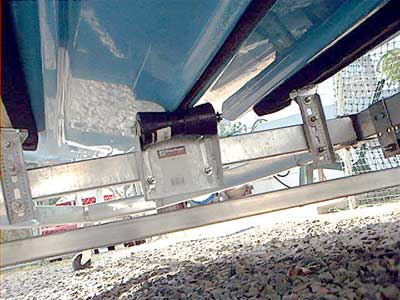
8 inch keel roller
I held off with the 5 inch roller . . . I would install that
after I saw where the forefoot would wind up. As it turned out,
simply reversing the angle & relocating the ‘tongue
roller’ accomplished the task.
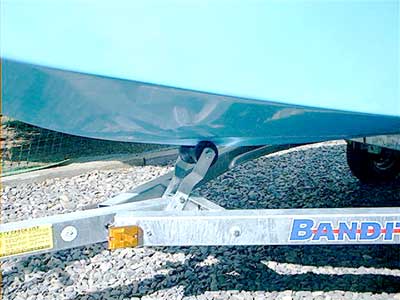
Forward Beam roller
The original trailer carried the boat with the stern about
40 inches beyond the rear end of trailer. About the same distance
& set-up as the larger P-19, and also how the present ‘factory’
P-15 trailers are arranged. When I first winched the boat to
this position two things bothered me {remember, I didn’t
have the ‘Self-Adjusting’ keel bunks at that time}.
The long bunks only had their front portions in contact with
the hull. From about the mid-point to the end there was an increasing
amount of space . . . about 4 inches at the aft end. Pushing
down on the stern, or motor mount, I could easily get the boat
to move like an old-fashioned ‘rocking horse’ !!
The other thing was only about 50 pounds of ‘tongue weight’.
While the books say 6 to 8 % is ‘normal’, I remembered
that the ‘original’ actually had more downward weight
than the tong on my 1200 pound P-19. I also feel a bit more
comfortable having about 75 to 100 pounds with such a ‘light
load’. {‘Tongue Weight’ is what keeps the
trailer in solid contact with the hitch, especially on rough
& variable surfaces. It also affects how the trailer ‘tracks’
the tow vehicle.} Winching the boat about 6 to 12 inches further
forward brought her almost fully onto the bunks, in a position
to allow the forefoot to be supported, and gave me a scale reading
of 98 pounds. A little adjusting of the bunk supports, relocating
the winch pedestal/bow stop, and ‘”Bob’s Your
Uncle !!”.
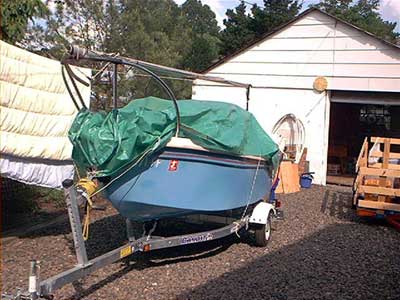
Port Bow front view
I also found that with the mass of the boat supported by the
rollers {the bunks mostly for ‘balance’}, it was
easy to push the boat rearward - to a more advantageous ‘launching
position’.
While times have changed, and the manufacturer you remembered
as making that ‘perfect’ trailer is no longer in
existence, or your in that position of making a ‘Re-furbish
or Buy New’ decision, don’t despair. A little thinking
{AHEAD is always good !}, a little ingenuity, and any problem
can be solved. {I’m waiting to get her back from the sailmakers
. . . I already have the materials to make a support for the
steel centerboard . . .}.
Oh, yea . . . my balls ? Well used & greasy . . .

Trailer & dolly balls photo

